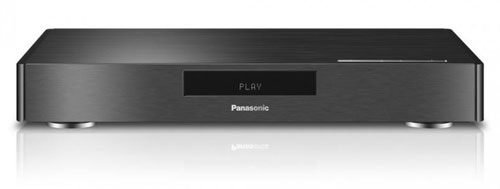The Blu-ray Disc Association (BDA) doesn’t have an official presence at the 2015 International CES (in the same way it did back in the vitriolic days where it had to compete with HD DVD), instead leaving the job of announcing details on the standard up to hardware manufacturers. At this morning’s 2015 CES Press Conference, Panasonic showed off their prototype Ultra HD Blu-ray Disc Player.

Here’s what we know about the new Ultra HD Blu-ray standard.
According to Panasonic’s press release, it’s ULTRA HD BLU-RAY, not “4K” Blu-ray. This makes sense seeing as the resolution of 3840×2160 is not the same as Digital Cinema 4K (4096×2160), and the industry is, on the whole, moving away from the “4K” moniker.
Unsurprisingly, the new discs will use the nascent HEVC (High Efficiency Video Coding) codec, aka H.265, and utilize a transfer rate of up to 100mbps (!) to support pristine ultra-high definition picture quality with low levels of data loss that streaming web services cannot currently hope to compete with.
For comparison, Netflix’s USA ISP Speed index reports that through the network of the fastest overall service provider, Verizon FIOS, it can only push a pitiful 3.27mbps from server to viewer, on average. In the UK, network conditions fare little better with the fastest provider, Virgin Media, at 3.49mbps. These average speeds are only a fraction of the internet service providers’ advertised speeds, so presumably issues such as congestion and net neutrality are at work here. There are no such networking complexities involved in getting data from disc to TV.
Although Panasonic haven’t officially confirmed disc capacity, in September 2013 we originally reported news of replication equipment being produced to allow the manufacturing of triple-layer, 100gb Blu-ray Discs, with about 33gb per layer.
There’s great news on the color gamut front, with the maximum allowable gamut being the gargantuan Rec.2020. Although the Rec.2020 gamut has been criticized as being impractically large and unattainable on video displays, it makes sense for the delivery mechanism to support as wide a gamut as possible, allowing for potential future expansion (if displays conforming to the Rec.2020 gamut were to somehow become available, the UHD BD standard will be there to meet the need). It’s far more likely that a more practical range of colors – such as those specified in the Digital Cinema Initiatives P3 gamut currently in use in movie theaters – will end up being used.
The video will be encoded at 10-bit precision, allowing, in theory, for almost no visible banding (posterization) artefacts. Higher-than-8-bit bit video was confusingly marketed some years ago by the video industry as “Deep Color”, no doubt causing mass confusion with consumers mistaking this feature for wide color gamut video.
In practice, current Blu-ray Discs can achieve video with little to no visible banding artefacts, despite being limited only to 8-bit precision (a sign of its early 2000s roots). However, this is only possible thanks to convoluted workarounds (dithering) being applied by compressionists during the disc production process. This is a tricky and inefficient workaround, and the fact that Ultra HD Blu-ray natively supports 10-bit video is excellent news.
UHD Blu-ray supports video at 3840×2160 at up to 60 frames per second – progressively (the CRT-centric concept of interlacing has thankfully not been allowed to make the jump to UHD). At this stage, we’re not sure if the high frame rate cinema speed of 48fps is supported natively, but the use of 60fps means that at worst, 48fps content could be stored on UHD Blu-ray with repeated frames. This is an improvement over existing Blu-ray, which allows for 60fps content only at 720p (the 1920×1080 resolution supports 24fps as it’s maximum progressive frame rate, with faster speeds requiring the use of archaic interlacing).
Perhaps one of the most interesting features of the new standard is the support for High Dynamic Range video. To do this properly, greater than 8-bit video is needed. As display brightness increases, the likelihood of visible banding also increases (a subject discussed in this BBC R&D white paper). Therefore, the introduction of HDR display panels requires higher-than-8-bit video to avoid banding becoming a problem.
Panasonic haven’t announced a street date or model number for any players yet, but by showing the prototype unit, the company is sending a clear signal that things are on track. We hope that Ultra HD Blu-ray players will be on store shelves for this Holiday shopping season – and if we can avoid a repeat of the original BD launch in 2006, a decent selection of software, too.
Source: Panasonic’s press release